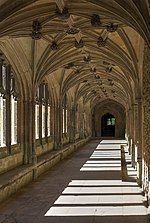Cocklemore Brook
Bristol Avon catchmentEngland river stubsRivers of WiltshireWiltshire geography stubs
The Cocklemore Brook is a short tributary of the Bristol Avon, some 2.5 miles (4.0 km) long. It rises near Studley in Wiltshire, England, and flows in a north and then westerly direction, draining the Pewsham area before passing underneath the former Wilts & Berks Canal and then joining the Bristol Avon near Lackham House, now home to Lackham College. An alternate name of Pewe Brook is recorded in the 14th century.
Excerpt from the Wikipedia article Cocklemore Brook (License: CC BY-SA 3.0, Authors).Cocklemore Brook
Double Bridge,
Geographical coordinates (GPS) Address Nearby Places Show on map
Geographical coordinates (GPS)
| Latitude | Longitude |
|---|---|
| N 51.4323 ° | E -2.1019 ° |
Address
Double Bridge
SN15 2QL , Lacock
England, United Kingdom
Open on Google Maps







